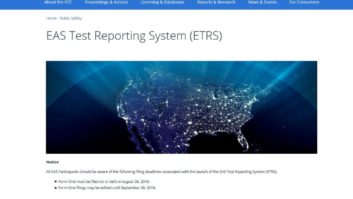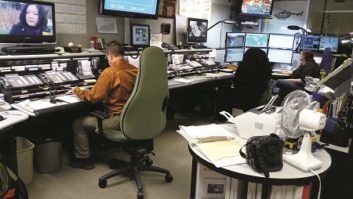Much has been written and discussed about the modernization of the Emergency Alert System.
Its roots are still planted in the old EBS system and the National Weather Service WRSAME system of 14 years ago. It’s certainly time we moved, kicking and screaming, into the 21st century, with technology and systems that can selectively and rapidly reach the maximum number of affected people in times of emergency.
Don’t fear the CAP
While any new technology brings fear, uncertainty and doubt, the coming EAS modernization isn’t going to be as difficult as some pundits would lead us to believe.
Since many EAS vendors have included Common Alerting Protocol compatibility in their new models (such as the Sage Digital ENDEC), almost 10 percent of broadcasters already have the EAS equipment they’ll need to receive CAP messages from state or local CAP servers. More stations will become CAP-ready as they replace or upgrade old equipment.

Several states have already added CAP to their capabilities. The National Weather Service has begun testing of their new CAP-based hazards dissemination system. Wade Witmer of the Federal Emergency Management Agency said at the 2009 NAB Show that CAP will be used to deliver messages to the PEP network, and proposes to test this capability before the 180-day clock starts.
The start of the FCC 180-day clock will simply accelerate a process that is already underway.
As CAP is rolled out, you won’t see much, if any, change to your day-to-day operation. The FCC EAS requirement remains; even after the 180-day clock expires, you’ll continue to receive EAS alerts over monitor receivers. Many of you will replace your 13-year-old EAS equipment and get voice synthesis, digital storage of text and audio for logging, network printers, Web browser interface for remote control, e-mail logging, automation interfaces and other features you’ve come to expect from any new piece of station gear. Your year-old new EAS gear may only need a downloadable software update to support the required version of CAP.
A new EAS/CAP device will continue to use filtering. You’ll select the alerts you air by type and geographic area. Audio hookups (digital or analog), LED signs, character generator interfaces, printers, GPIO will still apply. Your device will interrupt programming in the same way it does now, full automatic, manual assist or manual.
At the station level, you will need to integrate the new equipment. I don’t want to oversimplify, but the process won’t be mysterious and will be no more difficult than any data hookups you are doing now. It will be much like setting up a connection to a router, and if you can do that (or have the number of someone who can), it won’t be hard.
You may also have a redundant CAP path through a satellite receiver, an RF modem or a VPN connection to a distribution network.
While each state may have a slightly different twist on how CAP messages will get to you, the technology is known and is already being deployed in some areas.
Most of the remaining items to be resolved have to do with security; and again, the technology is known. The procedures to use it are being worked out.
One need that could use attention is a redundant relay for CAP messages. Since the raw CAP data is too large to send directly over the broadcast audio channel, a backup path from emergency management to broadcasters and cable systems is needed. Perhaps the FCC will take action on a proposal by the Society of Broadcast Engineers and others to allocate dedicated channels in the soon-to-be-auctioned 700 MHz “D block” spectrum for CAP relay use.
Availability
Recent articles wonder about the availability of EAS/CAP equipment.
Several vendors, Sage among them, have been shipping CAP-compatible systems since last year. We, and no doubt, they, are ready to ramp up production as needed.
The industry doesn’t need a delay in the process to invent the technology or build up inventory. Unlike the original EAS deployment in 1997, equipment manufacturers have had ample time to prepare and some systems are in the field before the clock starts.
What are we waiting for?
There are, of course, some additional issues to overcome before the CAP transition is ready to proceed.
Final tweaks to the protocol are being made; discussions on the best way to use the new tools by all participants (origination, relay, broadcasters, end users) are underway. Compliance testing will be formalized. New national and state dissemination systems will be tested. Training modules will be written.
All of the major EAS equipment vendors have been working together for more than a year to assure interoperability. The SBE has also been working on several committees to ensure that the needs of the broadcast community are known.
We applaud Wade Witmer’s decisive actions at FEMA to get the show on the road. And we applaud SBE, and especially Clay Freinwald and Gary Timm, for their tireless efforts on the industry’s behalf. We eagerly await the compatibility testing to begin.
If the industry does not get distracted by spurious issues, there is no reason that a new CAP EAS system could not be on the air in 2010, providing the public with timely and relevant information in times of emergency. Sage Alerting Systems stands ready to be part of the solution.
Jerry LeBow is vice president of Sage Alerting Systems and was one of its founders in 1996. He was a partner at Sage Broadcasting, holds several FCC licenses and is an active member of several EAS committees. He also is a founder of Mercury Energy, a renewable energy integrator based in New York.




